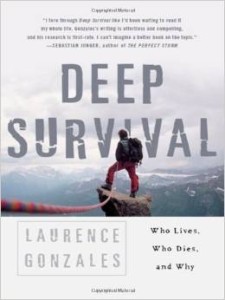Deep Survival – Who lives, Who dies, and Why – A book review
“Survivors always turn a bad situation into an advantage or at least an opportunity”
Some years ago I immersed myself in a most interesting book by Laurence Gonzales, a man who spent upwards of 35 years studying survivors and trying answer the questions of why did some live and some die, the compilation of all that research was put into book form as “Deep Survival – Who lives, Who dies, and Why” published by W.W. Norton in 2005.
Mr. Gonzales expertly skirts between deeply complex body and brain functions and using real life stories to illustrate various aspects in an interesting and inviting way. As I opened the pages of his book again, my mind was instantly taken back to when I read it last, recalling all the interesting things I learned.
When I have a printed book I always have a red pencil handy to mark things I want to remember and so in my review of the book I will pull some of these highlights to give a flavor of what you will find in it as you read it, which I highly recommend. There is a great deal of information relating to how the brain functions in a variety of situations, which is very helpful in understanding why we think the way we do.
The book is divided into two sections-
- How Accidents Happen
- Survival
The fifteen chapters contain lots of great stories which are analyzed to extract key elements of survival. This also keeps it interesting as a picture of the circumstance is drawn in the readers mind. The first section How Accidents Happen serves to dispel common wives tales, fears and traditions. It also shows us that some things can be prevented and some bad situations made better by understanding some of what makes things go wrong. Of course there are always things that happen that we simply cannot control and must therefore deal with them as they arise.
Here are some points in this section that I highlighted-
- “Fear is like fire. It can cook for you. It can heat your house. Or it can burn you down.” –by Cus D’Amato, quoted in the book
- Most decisions are not made using logic, and we all recognize that fact at least at an unconscious level. Further quoting LeDoux, “Unconscious operations of the brain is…the rule rather than the exception…”
- Psychologists who study survival say that people who are rule followers don’t do as well as those who are of independent mind and spirit
- Nature doesn’t adjust to our level of skill
- Richard Read, who would be dead within the hour, had been lead to believe that Mt Hood was a beginner’s mountain…
- The survivor does not impose pre-existing patterns on new information
Section Two – Survival
- The story of Ken Killip winds its way through this section and illustrates how someone competent and experienced can easily get caught in a terrible situation, and make it worse.
- Another of my favorite stories used in this section is Steve Callahan who spent 76 days at sea in a raft. I got his book and read it after reading about it in this book.
- Tip on group treks: “People routinely fail to realize that they have to travel at the speed of the slowest member, not the fastest.”
- Definition of being lost: “30 minutes of not knowing where you are.”
- “Although he needed a fire, wanted its warmth and light, he knew that open fires weren’t permitted in this part of the park…(If he had made a fire, he might have been seen and rescued sooner)”
- “Sometimes the one who survives is an inexperienced female hiker, while the experienced hunter gives up and dies in one night, even when it’s not that cold.”
- Amazingly the highest survival rate category is children six and under, “the very people we are most concerned about.”
- “You should operate at about 60% of your normal level of activity.”
And finally if you are part of a group in a survival situation some of the best advice discovered-
“Helping someone else is the best way to ensure your own survival. It takes you out of yourself. It helps you to rise above your fears. Now you’re a rescuer, not a victim.”
I could easily go on and on about this book, but you are just going to have to read it for yourself. If you are serious in learning about survival this book is a must read. No, it does not talk about starting a fire with a piston, or how to set a promontory peg to catch a meal, nor how to build a proper shelter, but without the information in this book, all those other skills and any gear you have may be of little value. As shown in the book many with all the skills, experience and gear have perished while those with nothing have survived the very same ordeal. Understanding how the brain and body function can prepare yourself to appropriately deal with difficulties as they arise, and understand why you feel and think the way you do. Who lives who dies is very different than you might imagine, the reasons why are profound.
Until next time, this is Perry Peacock, “Simplifying Survival”




Thanks for the review, Brother Peacock!
I really like the approach you describe the author having, as well as your own. Growing up in and around multiple wild environments, I didn’t realize that I was “surviving” until I got in the military and they gave it a name.
I love your products and as a hoodie-poncho guy I want to commend and congratulate you on adding a hoodie to your shelter liner. The EZ-Clips are a great offering too, the only thing I favor more, for an artificial solution, is when putting Grabbits on center portions of tarps, as tension points where no sew-through tabs are wanted.
Thanks again for the review, and keep up your excellent work,
Yours,
Mike